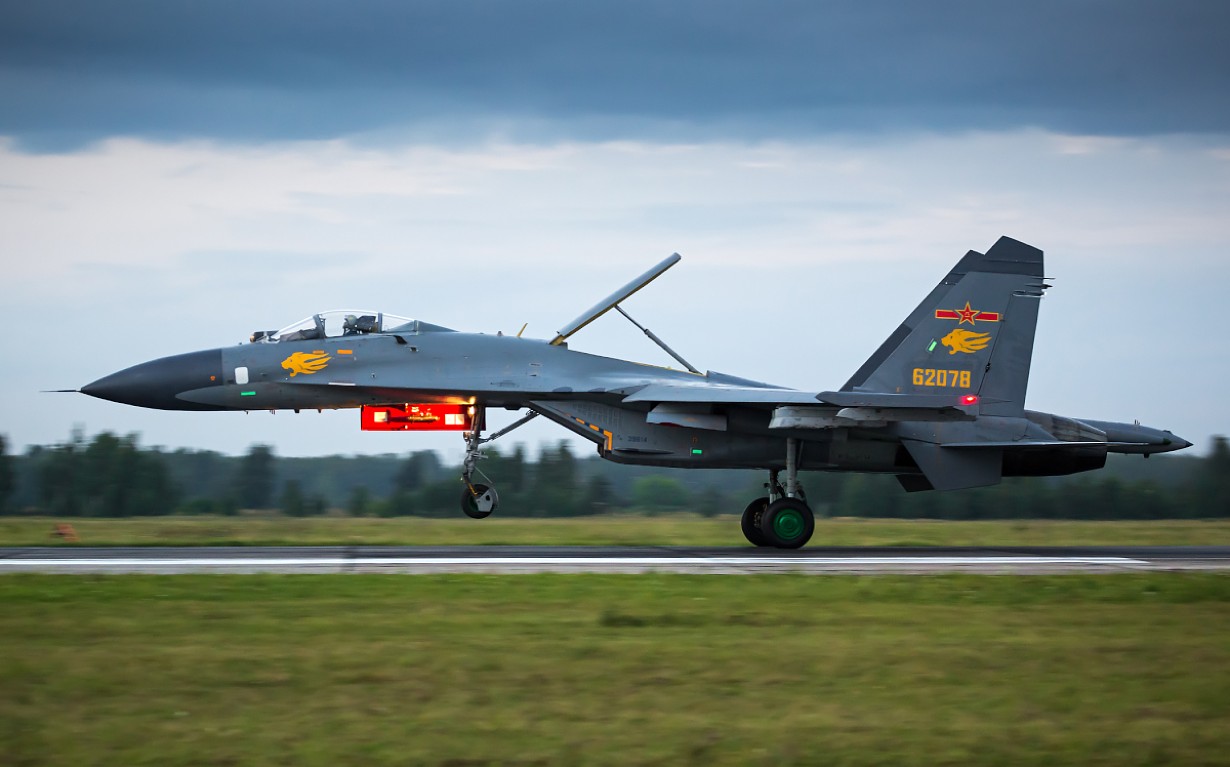The US military has alleged that a Chinese J-11 fighter pilot on October 24 engaged in an “unsafe intercept” of a US Air Force B-52H Stratofortress bomber over the fiercely disputed South China Sea.
This intercept marks the most recent event in an ongoing series of encounters between Chinese jets and aircraft operated by the US military and its allied forces. The US Indo-Pacific Command has made the video available on X, the social media platform previously known as Twitter.
The footage showcases what the command describes as a People’s Republic of China (PRC) J-11 fighter jet conducting “an unsafe intercept of a US Air Force B-52 aircraft.”
In a media release on October 26, the Command said, “J-11 pilot executed an unsafe intercept of a US Air Force B-52 aircraft, which was lawfully conducting routine operations over the South China Sea in international airspace.”
“During the night-time intercept, the PRC pilot flew in an unsafe and unprofessional manner, [and] demonstrated poor airmanship by closing with uncontrolled excessive speed, flying below, in front of, and within 10 feet of the B-52, putting both aircraft in danger of collision. We are concerned this pilot was unaware of how close he came to causing a collision,” the statement conveyed.
#USINDOPACOM Statement on #PRC Unprofessional Intercept: "A People’s Republic of China J-11 pilot executed an unsafe intercept of a U.S. Air Force B-52 aircraft which was lawfully conducting routine operations over the South China Sea…"
Read more⬇️https://t.co/UnCmnneAr7 pic.twitter.com/6k79Koah3V
— U.S. Indo-Pacific Command (@INDOPACOM) October 26, 2023
The incident is particularly noteworthy because it represents the first instance in which the US has officially reported an unsafe interception of a US bomber.
What further distinguishes this encounter is the fact that it took place during nighttime conditions. A video that has made the rounds on social media provides a visual record of the J-11 fighter’s apparent approach towards the US B-52.
In the footage, the fighter aircraft seems to temporarily vanish from view as it maneuvers behind the bomber, only to reappear moments later, creating a visual representation of the close encounter between the two aircraft.
The video was captured utilizing the Sniper pod attached beneath the wing of the B-52. The US military recently announced that B-52s had been dispatched to Andersen Air Force Base in Guam for forward-based Bomber Task Force missions.
China’s J-11 Fighter Aircraft
The aircraft responsible for the interception of a US bomber is also a two-seat J-11 affiliated with the Chinese People’s Liberation Army (PLA).
However, there is some uncertainty regarding whether it was under the operation of the PLA Air Force, possibly designating it as a J-11BS, or if it falls within the purview of the PLA Navy, which would categorize it as a J-11BSH.
The Shenyang J-11, a Chinese aircraft, is essentially a replica of the highly regarded Russian Sukhoi Su-27, also known as the “Flanker” multirole fighter. Initially, it began as an authorized copy, with Russia’s permission.
Later, China’s aspirations to enhance and modify it with domestically manufactured technology led to a transformation of its capabilities.
Since 1998, the People’s Liberation Army Air Force (PLAAF) has operated the J-11, a design that initially drew inspiration from the Russian Sukhoi Su-27.

In 1995, the PLAAF negotiated to secure a license, allowing them to produce 200 J-11s in China using a kit provided by Russia. However, the contract was halted after around 100 aircraft were built.
After that, the manufacturer, Shenyang Aircraft Corporation, continued production without authorization. This decision to keep manufacturing J-11s became a source of frustration for Russia, as Moscow had preferred that the engines and avionics continue to be produced in Russia.
The Shenyang Aircraft Corporation proceeded with the independent production of the J-11B, manufacturing it without any further involvement from Russia.
While approximately 90 percent of the J-11’s components were domestically manufactured in China, the airframe remained strikingly similar to the original Russian design.
This development caused considerable discontent within the Russian arms industry, which voiced concerns about potential intellectual property disputes for several years.
Since Beijing was one of the largest importers of Russian weapon systems, the situation did not escalate further, as Russia likely sought to preserve its valuable trade relationship with China.
The J-11B has been adapted to accommodate Chinese missiles and munitions, including the short-range PL-8 infrared-guided missile, a derivative of the Israeli Python 3.
Additionally, it is equipped with the long-range PL-12 radar-guided missile, often referred to as the “Chinese AMARAM,” boasting a range of up to one hundred kilometers.
The original J-11 was a Chinese-manufactured Su-27, closely following the Russian design. However, the J-11B marked a significant departure by incorporating Chinese hardware.
Within this category are sub-variants such as the J-11BS, a combat-capable two-seat trainer version, and the J-11BH, which serves the Naval Air Force.
A notable addition is the J-11BSH, a Navy version of the two-seat J-11BS, which is believed to have first come to public attention around 2010. The Navy variants of these aircraft operate from land bases and are not deployed on aircraft carriers.
- Contact the author at ashishmichel(at)gmail.com
- Follow EurAsian Times on Google News




